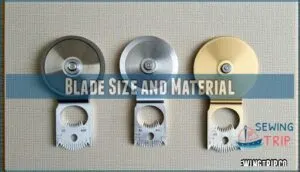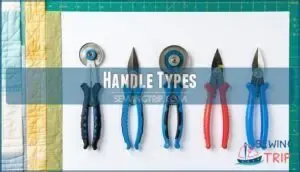This site is supported by our readers. We may earn a commission, at no cost to you, if you purchase through links.
 When you’re searching for what are the safest rotary cutters, look for models with automatic blade retraction and ergonomic handles.
When you’re searching for what are the safest rotary cutters, look for models with automatic blade retraction and ergonomic handles.
The Fiskars 60mm Titanium stands out with its squeeze-and-release safety mechanism, while OLFA’s RTY-2/G offers reliable blade guards.
You’ll want cutters with comfortable grips that won’t slip during use, because nobody wants a runaway blade situation.
Safety features like blade locks and protective covers aren’t just nice-to-haves—they’re essential for preventing accidents.
The best models balance sharp cutting performance with foolproof safety mechanisms.
Understanding blade sizes, handle materials, and proper cutting techniques can make all the difference in your crafting experience.
Table Of Contents
Key Takeaways
- You’ll want to prioritize rotary cutters with automatic blade retraction and safety locks, as these features prevent accidental blade exposure and significantly reduce injury risks during crafting projects.
- Choose models with ergonomic handles and soft-grip surfaces that won’t slip during use, since comfortable grips reduce hand fatigue and give you better control during extended cutting sessions.
- Consider blade size carefully – 28mm blades work best for intricate cuts, 45mm offers versatility for most quilting tasks, and 60mm handles thick materials, so match your blade to your typical projects.
- Invest in quality blade materials like titanium-coated or tungsten steel options, as they stay sharper longer, require less frequent replacement, and provide safer cutting performance compared to standard steel blades.
What Are The Safest Rotary Cutters?
You’ll want to prioritize rotary cutters with automatic blade retraction, ergonomic safety locks, and protective blade guards to minimize injury risks during your crafting projects.
The safest models combine these essential features with comfortable handles and reliable mechanisms, ensuring you can cut fabric confidently without worrying about accidental blade exposure, using ergonomic safety locks.
Fiskars 60mm Titanium Rotary Cutter
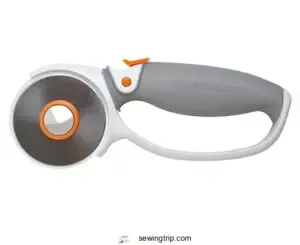 View On Amazon
View On Amazon
Safety often takes a backseat to performance, but the Fiskars 60mm Titanium Rotary Cutter proves you don’t need to compromise.
Safety meets precision—no compromises needed when you choose the right rotary cutter for your crafting arsenal.
Its titanium carbide-coated blade cuts three times harder than standard steel, slicing through multiple fabric layers effortlessly.
The non-slip SoftGrip handle prevents accidents during extended use, while the sliding safety button locks the blade securely.
You’ll appreciate the ambidextrous design that accommodates both right and left-handed crafters with equal precision.
Proper storage helps extend tool life to ensure the longevity of your tool and maintain its performance.
Best For: Professional and hobbyist crafters seeking a durable, precise rotary cutter for quilting, sewing, or crafting projects.
- Titanium-coated blade ensures precise cuts and long-lasting sharpness.
- Ambidextrous, ergonomic design provides comfort during extended use.
- Safety lock mechanism prevents accidental blade exposure.
- High price point may discourage casual users.
- Large blade size unsuitable for detailed, intricate work.
- Sharp blade requires extra caution to avoid injuries.
Soft Grip 28mm Rotary Cutter
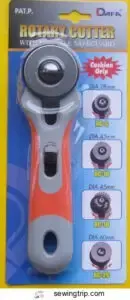
The 28mm Soft Grip Rotary Cutter strikes the perfect balance between precision and comfort.
You’ll appreciate its cushioned handle that reduces fatigue during those marathon quilting sessions.
The flexible safeguard automatically adjusts based on your pressure, making it foolproof for both beginners and pros.
What sets this cutter apart is its ambidextrous design – no need for reassembly when switching hands.
The one-button blade change system means you won’t fumble with complicated mechanisms.
Its compact size excels at intricate cuts and curves that larger cutters can’t handle.
The locking mechanism keeps the blade secure when stored, preventing those heart-stopping moments when you reach into your craft box.
It’s your reliable partner for detailed work.
Best For: Hobbyist and professional crafters looking for a precise, lightweight, and comfortable rotary cutter for intricate and detailed work.
- Ergonomic soft grip handle reduces hand and wrist fatigue.
- Ambidextrous design offers seamless use for both left and right-handed users.
- Compact size allows for precise cutting on curves and intricate designs.
- Blade sharpness may diminish with frequent use, requiring replacement.
- Not suitable for heavy-duty or thick materials beyond the recommended range.
- Requires careful handling and storage to ensure longevity.
OLFA Rotary Cutter RTY-2/G
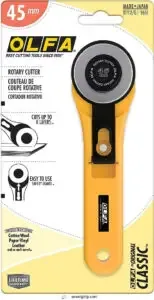
When precision meets versatility, the OLFA Rotary Cutter RTY-2/G stands out as a game-changer for crafters.
This ambidextrous design works seamlessly for both lefties and righties, delivering clean, straight cuts with surprisingly little effort.
Its smaller blade proves sharper than many competitors, making quick work of fabric layers, and the straight handle feels natural in your hand, reducing fatigue during extended cutting sessions.
Highly praised in quilting circles, this cutter transforms tedious cutting tasks into smooth, efficient operations that’ll have you wondering how you managed without it, making it a perfect tool for those who value precision and versatility, and consider it an essential crafting tool.
Best For: Quilters, sewing enthusiasts, and crafters who need a precise, ergonomic, and versatile cutting tool.
- Smaller blade size requires careful handling to avoid accidents.
- May not appeal to those who prefer larger cutting tools.
- Sharpness necessitates secure storage to ensure safety.
- Ambidextrous with an ergonomic design that reduces hand and wrist fatigue.
- Sharp tungsten steel blade for clean, accurate cuts.
- Ideal for cutting through fabric, paper, and tough materials like rubber sheets.
NICAPA 45mm Fabric Rotary Cutter Set
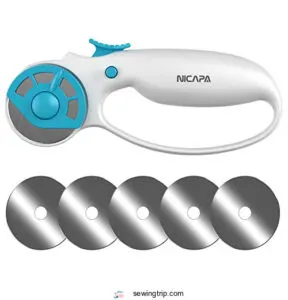
Crafters know that good tools make all the difference in their projects.
The NICAPA 45mm Fabric Rotary Cutter Set delivers exactly what you need for safe, precise cutting.
Its precision-ground stainless steel blade cuts through multiple fabric layers effortlessly, while the ergonomic loop handle reduces hand fatigue during long sessions.
You’ll appreciate the dedicated safety button that locks the blade securely when not in use. Plus, with five replacement blades included, you’re getting exceptional value that keeps your creative momentum going strong.
Best For: Crafters, quilters, and hobbyists who need a reliable, ergonomic tool for cutting fabric, paper, felt, or vinyl.
- Precision-ground stainless steel blade for clean, accurate cuts.
- Ergonomic loop handle reduces joint fatigue during extended use.
- Includes 5 replacement blades, providing great value and longevity.
- Blade size may not be ideal for very intricate cutting patterns.
- Requires occasional maintenance to keep the blade sharp.
- Safety button may stiffen slightly with frequent use.
Most Important Factors to Consider When Purchasing a Rotary Cutter
When you’re shopping for a rotary cutter, you’ll want to focus on three critical elements that directly impact both safety and performance.
The blade diameter, blade material quality, and built-in safety features will determine whether you end up with a reliable cutting tool or a frustrating accident waiting to happen.
Blade Diameter
Blade diameter directly impacts your rotary cutter safety and cutting performance. Think of it as choosing the right tool for the job – you wouldn’t use a sledgehammer to hang a picture frame.
The diameter you select affects everything from maneuverability to cutting thickness capabilities.
Here’s how different blade diameters serve specific needs:
- 28mm blades – Perfect for intricate curves and detailed work on lightweight fabrics
- 45mm blades – The sweet spot for most quilting and general fabric cutting tasks
- 60mm blades – Ideal for cutting through multiple layers and thick materials efficiently
- Larger diameters – Provide better user comfort during extended cutting sessions
- Smaller diameters – Offer superior control for precision work and tight spaces
Choose based on your typical project scale and fabric type for maximum safety. You can find a 28mm blade online for replacement purposes.
Blade Material
Understanding the right blade material transforms your cutting experience from frustrating to fantastic. The material you choose directly impacts sharpness retention, durability, and overall rotary cutter safety.
Here’s what separates the good from the great:
- Stainless Steel Blades: These workhorses offer reliable performance at budget-friendly prices. They’re perfect for everyday crafting projects and provide decent blade sharpness for moderate use. While they require more frequent replacement, they’re widely available and easy to maintain.
- Titanium-Coated Blades: The gold standard for material durability. These specialty blades stay sharper longer, resist corrosion, and glide through multiple fabric layers effortlessly. They’re the safest rotary cutters’ secret weapon, though replacement costs run higher. Titanium blades offer superior sharpness and can last up to three times longer than steel blades.
- Tungsten Steel Options: Extremely hard and long-lasting, these blades excel at maintaining their edge. They’re ideal for heavy-duty projects requiring consistent precision.
Your blade maintenance routine becomes simpler with higher-quality materials.
Steel vs. Titanium comes down to budget versus performance—titanium wins for serious crafters prioritizing blade safety and longevity.
Safety Features
Several critical safety features distinguish the safest rotary cutters from basic models.
Automatic blade retraction immediately covers the cutting edge when you release pressure, preventing accidental cuts.
Ergonomic handles with soft-grip surfaces reduce hand fatigue while providing better control during extended cutting sessions.
Locking mechanisms secure the blade during storage, eliminating the risk of rotary cutter accidents when the tool isn’t in use.
Quality storage solutions include protective blade covers and designated cases that keep cutters away from children.
Regular maintenance safety practices, like replacing dull blades promptly, guarantee maximal blade safety and prevent dangerous slipping during cuts.
Storing cutters in a case helps to isolate the cutter when not in use, which is a crucial aspect of rotary cutter safety and overall tool maintenance.
How to Use a Rotary Cutter
Making the shift from scissors to rotary cutter feels like upgrading from a horse-drawn cart to a sports car—exciting but requiring new skills. Your journey to safe, precise cutting starts with proper setup and technique.
First, place your fabric on a selfhealing mat. This protects your surfaces and keeps your rotary cutter blade sharp longer. Position a thick ruler firmly against your cutting line, applying downward pressure to prevent slipping. Hold your rotary cutter with confidence but not tension—think firm handshake, not death grip.
Roll the blade away from your body in one smooth motion, maintaining consistent blade pressure throughout the cut. For straight cuts, keep the cutter perpendicular to the fabric. Curve cutting requires slower, more deliberate movements with the blade tilted slightly.
Safety-focused rotary cutter techniques include:
- Always retract the blade immediately after each cut
- Never leave an exposed blade unattended, even for seconds
- Keep your non-cutting hand positioned safely behind the ruler
Master proper fabric handling by smoothing wrinkles before cutting and supporting loose edges. Selecting the right cutter involves handle comfort considerations.
Choosing The Right Rotary Cutter for Your Needs
You’ll need to match your rotary cutter to your specific projects, since the wrong blade size can turn a simple fabric cut into a frustrating wrestling match.
Consider your typical materials and cutting patterns carefully, as factors like blade diameter, handle comfort, and safety features directly impact both your cutting precision and long-term hand health.
The choice of rotary cutter is crucial for cutting precision, and it directly affects your work experience and the quality of your output.
Blade Size and Material
Your rotary cutter blade’s size and material determine cutting success. The 45mm blade offers the sweet spot for versatility, handling 2-3 fabric layers effortlessly.
Meanwhile, 28mm blades excel at intricate cuts, and 60mm options tackle thick materials like champions.
When comparing blade material options, tungsten steel delivers superior blade durability over standard alternatives. These professional-grade options maintain blade sharpness longer, reducing frequent blade replacement needs.
Cost comparison shows tungsten blades cost more upfront but provide better long-term value.
Size applications matter substantially – larger rotary cutter blade sizes cut more layers simultaneously, while smaller sizes offer precision control.
Material durability directly impacts your cutting experience and safety. Choosing the right blade means considering rotary cutter sizes for the project.
Handle Types
Handle comfort can make or break your cutting experience, especially during long quilting sessions. Ergonomic design features like squeeze triggers and curved shapes reduce hand fatigue while providing superior control.
Ambidextrous handles accommodate both left and right-handed users, ensuring everyone can cut safely. Handle materials range from lightweight plastic to cushioned rubber grips that absorb shock and prevent slipping.
For ideal comfort, consider using an ergonomic rotary cutter. Pivoting handles with self-retracting blades represent the safest rotary cutters available, automatically engaging safety features to prevent rotary cutter injuries through intelligent ergonomic handles that prioritize your safety.
Frequently Asked Questions (FAQs)
Which rotary cutters are safe?
Like a security guard for your fingers, Fiskars cutters lead the pack with automatic blade retraction and ergonomic handles.
You’ll also find excellent safety features in OLFA models with their reliable locking mechanisms and blade guards.
Which rotary cutter is best for cutting fabric?
For cutting fabric, you’ll want a 45mm rotary cutter with ergonomic handles and safety features.
Fiskars and OLFA models offer excellent blade quality, comfortable grips, and automatic retraction mechanisms for precise, safe cuts.
Do rotary cutters have a safety lock?
Yes, most modern rotary cutters feature safety locks.
You’ll find automatic blade retraction, lock buttons, and blade guards that prevent accidental cuts.
These mechanisms keep the blade safely tucked away when you’re not actively cutting, utilizing features like automatic blade retraction.
Which rotary cutter should I use?
Finding your perfect rotary cutter is like choosing the right dance partner—it needs to move with you effortlessly.
You’ll want the Fiskars Easy Change Ergo Control for its superior safety features, ergonomic design, and reliable blade retraction mechanism, which offers superior safety.
Are 45mm rotary cutters good for cutting fabric?
You’ll find 45mm rotary cutters perfect for fabric cutting—they’re the sweet spot between precision and power.
They handle multiple layers beautifully, cut straight lines like butter, and work great for quilting projects.
Are rotary cutter blades Good?
Rotary cutter blades deliver exceptional performance when you maintain them properly.
They’re sharper than scissors, lasting 4-6 hours of cutting time.
You’ll get cleaner edges and smoother cuts through multiple fabric layers effortlessly.
What are the disadvantages of rotary cutters?
You’ll face exposed blade risks, potential severe cuts, and accidents more dangerous than scissors.
They’re not suitable for delicate fabrics, require expensive blade replacements, and need constant safety awareness during use.
How to pick a rotary cutter?
What matters most when choosing your cutting companion?
Consider blade size for your projects—28mm for precision, 45mm for versatility, 60mm for thick materials.
Prioritize safety features like automatic blade retraction and ergonomic handles that fit comfortably.
What are the two types of rotary cutters?
You’ll encounter two main types of rotary cutters: manual and electric.
Manual cutters require your hand pressure to slice through fabric, while electric models use motorized blades for effortless cutting through thick materials.
How do you use a rotary cutter safely?
Always use a cutting mat and thick ruler for guidance.
Keep your blade retracted when not cutting, store it safely away from children, and replace dull blades promptly to prevent slipping accidents.
Conclusion
Finding peace of mind while crafting shouldn’t feel like traversing a minefield.
When determining what’re the safest rotary cutters, prioritize automatic blade retraction, ergonomic handles, and reliable safety locks.
The Fiskars 60mm Titanium leads with its squeeze-and-release mechanism, while OLFA’s RTY-2/G delivers consistent protection.
Remember, investing in quality safety features isn’t just smart—it’s essential for accident-free crafting, and will help you cut confidently.
Choose wisely, cut confidently, and keep those fingers intact for your next creative project.

